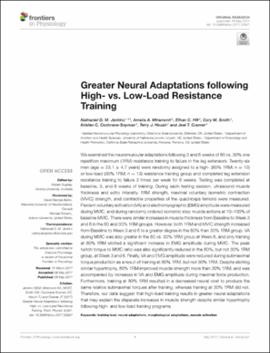| dc.contributor.author | Jenkins, Nathaniel D. M. | |
| dc.contributor.author | Miramonti, Amelia A. | |
| dc.contributor.author | Hill, Ethan C. | |
| dc.contributor.author | Smith, Cory M. | |
| dc.contributor.author | Cochrane-Snyman, Kristen C. | |
| dc.contributor.author | Housh, Terry J. | |
| dc.contributor.author | Cramer, Joel T. | |
| dc.date.accessioned | 2019-08-28T16:00:44Z | |
| dc.date.available | 2019-08-28T16:00:44Z | |
| dc.date.issued | 2017-05-29 | |
| dc.identifier | oksd_jenkins_greaterneuralad_2017 | |
| dc.identifier.citation | Jenkins, N. D. M., Miramonti, A. A., Hill, E. C., Smith, C. M., Cochrane-Snyman, K. C., Housh, T. J., & Cramer, J. T. (2017). Greater neural adaptations following high- vs. low-load resistance training. Frontiers in Physiology, 8, Article 331. https://doi.org/10.3389/fphys.2017.00331 | |
| dc.identifier.uri | https://hdl.handle.net/11244/321362 | |
| dc.description.abstract | We examined the neuromuscular adaptations following 3 and 6 weeks of 80 vs. 30% one repetition maximum (1RM) resistance training to failure in the leg extensors. Twenty-six men (age = 23.1 +/= 4.7 years) were randomly assigned to a high- (80% 1RM; n = 13) or low-load (30% 1RM; n = 13) resistance training group and completed leg extension resistance training to failure 3 times per week for 6 weeks. Testing was completed at baseline, 3, and 6 weeks of training. During each testing session, ultrasound muscle thickness and echo intensity, 1RM strength, maximal voluntary isometric contraction (MVIC) strength, and contractile properties of the quadriceps femoris were measured. Percent voluntary activation (VA) and electromyographic (EMG) amplitude were measured during MVIC, and during randomly ordered isometric step muscle actions at 10-100% of baseline MVIC. There were similar increases in muscle thickness from Baseline to Week 3 and 6 in the 80 and 30% 1RM groups. However, both 1RM and MVIC strength increased from Baseline to Week 3 and 6 to a greater degree in the 80% than 30% 1RM group. VA during MVIC was also greater in the 80 vs. 30% 1RM group at Week 6, and only training at 80% 1RM elicited a significant increase in EMG amplitude during MVIC. The peak twitch torque to MVIC ratio was also significantly reduced in the 80%, but not 30% 1RM group, at Week 3 and 6. Finally, VA and EMG amplitude were reduced during submaximal torque production as a result of training at 80% 1RM, but not 30% 1RM. Despite eliciting similar hypertrophy, 80% 1RM improved muscle strength more than 30% 1RM, and was accompanied by increases in VA and EMG amplitude during maximal force production. Furthermore, training at 80% 1RM resulted in a decreased neural cost to produce the same relative submaximal torques after training, whereas training at 30% 1RM did not. Therefore, our data suggest that high-load training results in greater neural adaptations that may explain the disparate increases in muscle strength despite similar hypertrophy following high- and low-load training programs. | |
| dc.format | application/pdf | |
| dc.language | en_US | |
| dc.publisher | Frontiers Media | |
| dc.rights | This material has been previously published. In the Oklahoma State University Library's institutional repository this version is made available through the open access principles and the terms of agreement/consent between the author(s) and the publisher. The permission policy on the use, reproduction or distribution of the material falls under fair use for educational, scholarship, and research purposes. Contact Digital Resources and Discovery Services at lib-dls@okstate.edu or 405-744-9161 for further information. | |
| dc.title | Greater neural adaptations following high- vs. low-load resistance training | |
| osu.filename | oksd_jenkins_greaterneuralad_2017.pdf | |
| dc.description.peerreview | Peer reviewed | |
| dc.identifier.doi | 10.3389/fphys.2017.00331 | |
| dc.description.department | Health and Human Performance | |
| dc.description.department | Nutritional Sciences | |
| dc.type.genre | Article | |
| dc.type.material | Text | |
| dc.subject.keywords | neural adaptation | |
| dc.subject.keywords | training load | |
| dc.subject.keywords | morphological adaptation | |
| dc.subject.keywords | muscle activation | |
